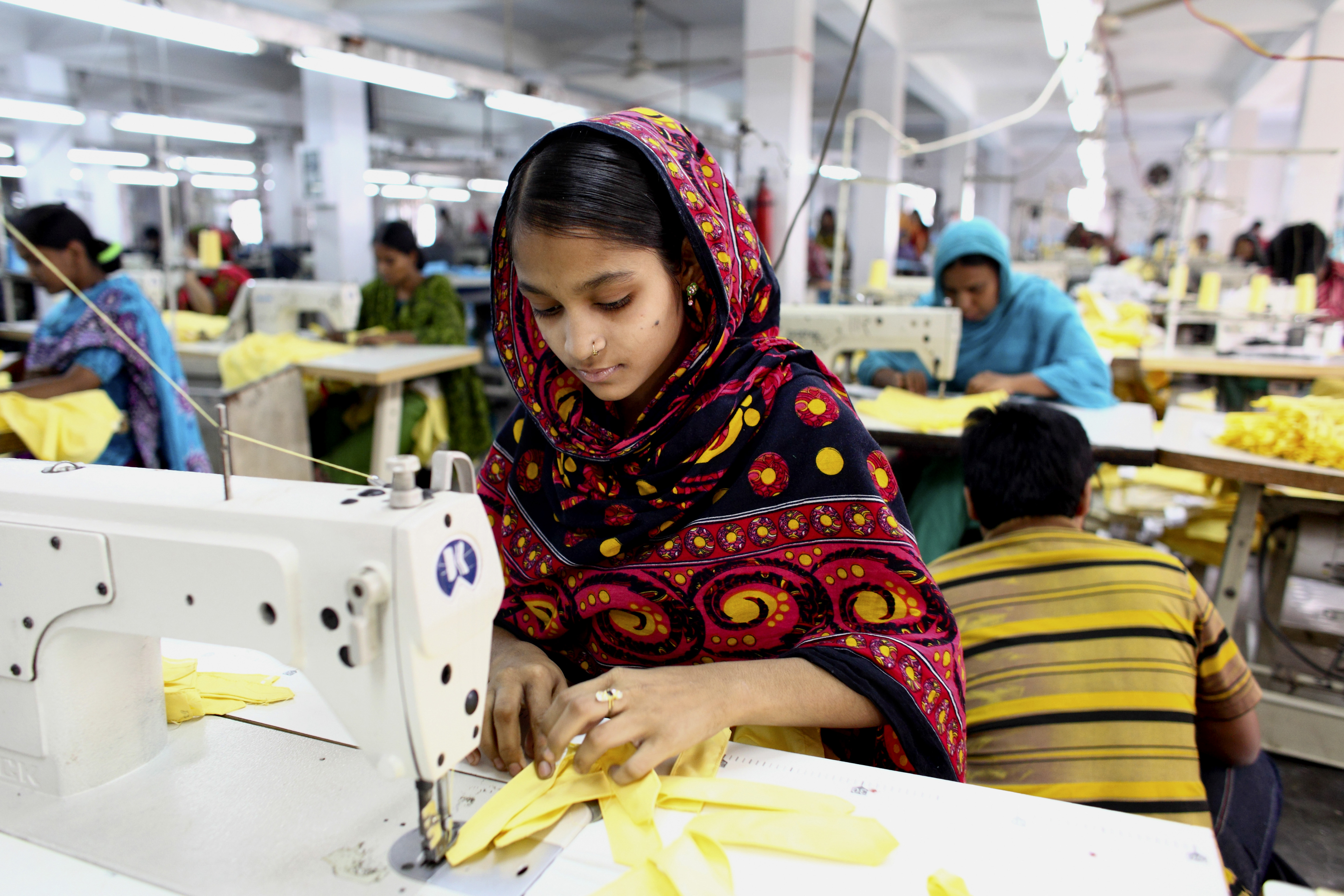


Bangladesh is the second largest exporter of ready-made garments in the world, after China.[1] The growth of the industry has been dramatic. In the 1983-4 fiscal year, Bangladesh exported garments worth just over US$31.5 million, and employed 120,000 workers in 384 factories. By 2013-14 it exported garments worth more than US$24 billion, and employed some 4 million workers in 4,536 factories.[2] Garments account for almost 80 percent of the country’s export earnings and contribute more than 10 percent of GDP. [3]
According to the industry’s most powerful trade body, the Bangladesh Garment Manufacturers and Exporters Association (BGMEA), factories have played an important role in alleviating poverty in Bangladesh “through skills development and employment generation.” More than 20 million people depend directly and indirectly on the industry, according to the BGMEA.[4] Eighty percent of the workers are women.[5] According to the ILO “the industry is the major driver of Bangladesh’s development. Most workers are women from poor backgrounds for whom jobs in the RMG sector are a lifeline out of poverty. Continued growth of the garment industry is critical for eradication of poverty in Bangladesh.”[6]
Although the government increased the minimum wage in late 2013, Bangladesh has historically paid its garment workers less than its major competitors, and has a record of poor industrial relations.[7] In November 2013, the government deployed a paramilitary force, the Border Guard Bangladesh, to help quell violent protests by workers seeking an increase to the minimum wage.[8] In December 2013, the government raised the minimum wage to US$68/month from US$39/month, bringing it closer to the wages paid in other Asian countries, but still significantly less than the workers had demanded.[9]
Trade unions are legal in Bangladesh but, as discussed later in this report, workers seeking to form unions face an often daunting environment—including at times violent retaliation, termination of employment, and other violations— as well as arbitrary barriers to registration, and harassment and retaliation once a union is established. In one of the worst cases, labor activist Aminul Islam was abducted, tortured, and killed in April 2012, and to date his killers have not been found.[10]
Amendments to the labor law in July 2013 have made registering a union easier. Factors such as international pressure following the disasters at the Rana Plaza and Tazreen factories, and the government’s hope that the United States might reinstate suspended GSP trade benefits, have led to improved government response in registering trade unions. But even with the recent new union registrations, unions exist in fewer than 10 percent of garment factories in Bangladesh today.[11]
The rapid rate at which the industry has grown, as well the failure of the Bangladesh government to enforce its building and labor regulations, has resulted in many unsafe and poorly constructed factories. On April 24, 2013, Bangladesh witnessed the worst industrial disaster in its history when the Rana Plaza building collapsed, killing more than 1,100 workers and leaving hundreds more badly injured.[12] A government investigation found that there had been a series of irregularities in its construction—the top two floors were added illegally and the building was not designed or built for industrial use.[13] Five months before the Rana Plaza tragedy, Bangladesh’s deadliest factory fire occurred, at the Tazreen Fashions factory, killing at least 112 people.[14]
These were not isolated incidents. Factory fires alone killed almost 500 workers between 2006 and 2010, according to fire department figures quoted by the Clean Clothes Campaign.[15] In April 2005, 64 workers were killed when the Spectrum factory collapsed.[16] Since the Tazreen fire, the Solidarity Center has tracked at least 68 garment factory fire incidents, in which 30 people were killed and more than 800 people—most of them women—injured.[17]
Since the Rana Plaza accident, Bangladesh has come under intense pressure to reform the industry, both from retailers considering pulling their supply chains out of the country, as well as from major donor nations. The United States suspended Generalized System of Preferences (GSP) trade benefits in June 2013 because, as President Barack Obama phrased it, Bangladesh was “not taking steps to afford internationally recognized worker rights to workers in the country.”[18] The European Union also threatened to remove trade benefits for Bangladesh garment exports if reforms did not take place. [19]
In July 2013, Bangladesh signed a Sustainability Compact with the European Union to improve labor rights with a particular focus on freedom of association and collective bargaining; occupational safety and health and factory safety; and supporting and promoting responsible business conduct.[20] A stock-taking report produced a year later noted some achievements. These included the adoption of an amended labor law in July 2013 which made it easier for workers to establish trade unions, including by streamlining the process for registration of new unions, and called for the hiring of new factory inspectors. But the EU report added that the country’s labor law needed further amendments to fully comply with core international labor standards. It also called on the Bangladesh government to address “reports of denials to register trade unions, anti-trade union discrimination, intimidation, and harassment.”[21]
Additionally, three separate initiatives to inspect the factories for safety are underway. The first, the Accord on Fire and Building Safety, is being run on behalf of 175 retailers, most of which are based in Europe.[22] The signatories of this legally binding agreement are responsible for inspecting and overseeing improvements in 1,611 factories.[23] Members of this ground-breaking initiative also include trade unions and campaign groups. The second initiative, the Alliance for Bangladesh Worker Safety, is inspecting and overseeing improvements in 587 factories.[24] The Alliance is a group of 26 North American retailers, including Walmart and Gap. Finally, the government’s own inspectors, supported by the ILO and funded by the EU, are inspecting and overseeing improvements in the remaining factories, which number about 1,500.[25]